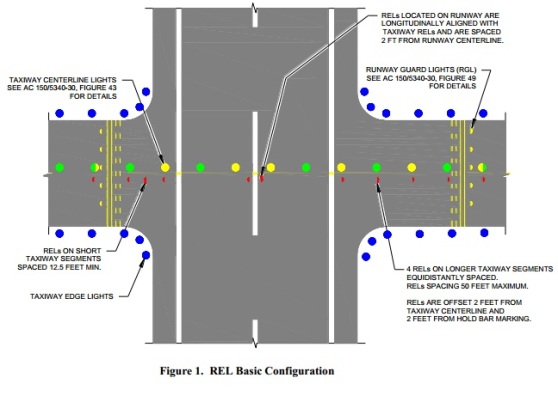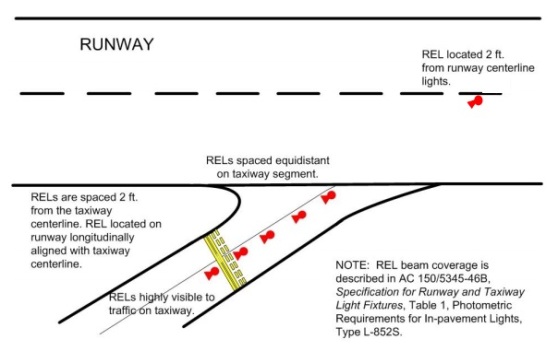We have often seen runway status lights at airports from the window of our airplane or the terminal. Here are the specifications on runway entrance lights (REL), methodology and configurations used, as detailed in the FAA Engineering Brief #64D.
The following standards apply for the Runway Entrance Light fixtures (Type L-852S)
configurations:
- Basic Configuration (straight taxiway perpendicular to the runway)
- Angled Configuration (straight taxiway not perpendicular to the runway)
- Curved Configuration (curved taxiway at a varying angle to the runway)
RELs are installed parallel to the taxiway centerline per Figure 1. RELs are spaced laterally 2 feet (ft.) from the taxiway centerline, on the opposite side of taxiway centerline lights (if installed). The first light in the pattern is installed 2 ft. prior to the runway holding position marking. Longitudinal spacing must conform to the standards. The penultimate light is installed 2 ft. prior to the runway edge stripe, and the last light is installed 2 ft. to the side of the runway centerline lights toward the intersecting taxiway.
4.2.1. Basic (90-degree) Configuration.
This is the most common and simplest form of intersection. Because the taxiway centerline is perpendicular to the runway centerline, the longitudinal line of RELs is also perpendicular to the runway, and all the lights are aimed along the taxiway path, that is perpendicular to the runway centerline.
4.2.2. Angled Configuration.
This configuration is used where the intersecting taxiway is not perpendicular to the runway centerline but not less than 60 degrees from the runway centerline. The location and spacing of the REL lights along the taxiway centerline is identical to the one used for perpendicular intersections. For highly angled taxiways (e.g. less than 60 degrees from the runway centerline heading), the fixtures used and aiming will be determined on a case-by-case basis.
4.2.3. Curved Configuration.
When the taxiway centerline marking between the holding position marking and the runway is curved, the maximum REL longitudinal spacing must be based on standards. The runway centerline REL will be located on the extended line of the last two longitudinal lights near the runway edge. Where a tangent to the curve of the taxiway centerline intersects the runway centerline at not less than 60 degrees, aiming must comply with standards for taxiway centerline lights. When the angle is less than 60 degrees, aiming must be determined on a case-by-case basis.

